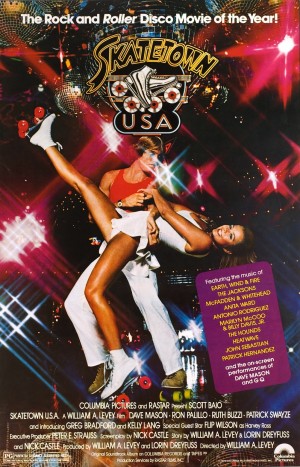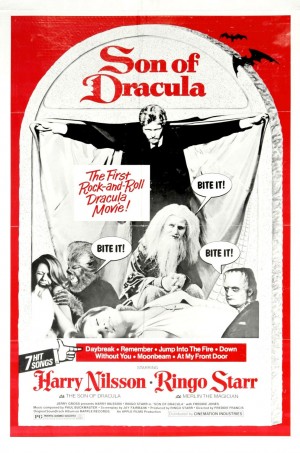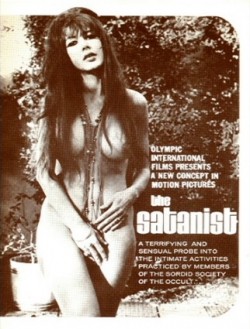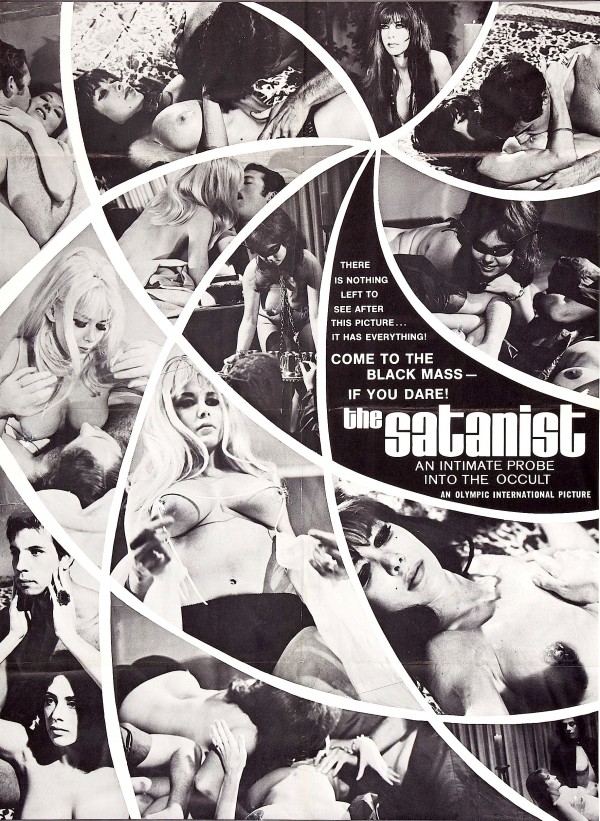SKATETOWN U.S.A. (1979, directed by William A. Levey, 98 min., U.S.)
SON OF DRACULA (1974, directed by Freddie Francis, 90 min., U.K.)
BLOOD (1974, directed by Andy Milligan, 69 minutes, U.S.)
MURDER ON THE EMERALD SEAS (1973, directed by Alan Ormsby, 85 min., U.S.)
THE SATANIST (1968, directed by Zoltan G. Spencer, 64 min., U.S.)
 BY DAN BUSKIRK FILM CRITIC The Philly-based cinema curators of Exhumed Films traffic in the weird, wild and often disrespected fringes of cinema history. What started 17 years ago as a forum to present 35mm prints of the modern classics of contemporary horror has, over time, widened to include all sorts of little-seen genre films from decades past, from blaxploitation, Italian crime films, sex comedies and some films that are just plain unclassifiable. This latest show is their bravest program yet, a master’s class in oddball vehicles, the draw being that these films have for the most part been abandoned since their inception, left un-revived by cable or home video. It’s a fantastically curious batch of films and for genre lovers (especially of that magic movie era of the 1970s) it is a chance to forever trump your movie buff buddies in the ‘Have you seen this?’ game.
BY DAN BUSKIRK FILM CRITIC The Philly-based cinema curators of Exhumed Films traffic in the weird, wild and often disrespected fringes of cinema history. What started 17 years ago as a forum to present 35mm prints of the modern classics of contemporary horror has, over time, widened to include all sorts of little-seen genre films from decades past, from blaxploitation, Italian crime films, sex comedies and some films that are just plain unclassifiable. This latest show is their bravest program yet, a master’s class in oddball vehicles, the draw being that these films have for the most part been abandoned since their inception, left un-revived by cable or home video. It’s a fantastically curious batch of films and for genre lovers (especially of that magic movie era of the 1970s) it is a chance to forever trump your movie buff buddies in the ‘Have you seen this?’ game.
First up is the best-known of the batch, 1979’s Skatetown U.S.A., which actually received a brief wide release from Columbia Pictures in October of 1979. I had originally caught it on HBO in the year following its release and found it mildly-diverting but the film is a great example of how time can radically change a movie’s impact. Made in the wake of monster hits like Saturday Night Fever and Grease, the producers thought their timing was dead-on for a blockbuster built around the brief craze of  roller discos. A DJ known as “The Wizard” literally brings the scene to life as a night at the glamorous roller skating rink reveals a lot of hi-jinks afoot, culminating with a dangerous skatedown between Stan (sometime adult film star Greg Bradford) and the demoniacally intense Ace (Patrick goddamn Swayze, in his debut). It is the breath-taking Hollywood Palladium (built in 1940 and host to a lot of Lotus Land history) that stands in for titular skating rink, and, all dolled-up, the location is a star in its own right. In fact, the movie is reminiscent of the variety musicals of the ’30s and ’40s, featuring numerous comics (Letterman pal Gary Mule Deer and The Gong Show‘s Murray Langston) musical acts (oddly enough, Traffic’s groovy hippie Dave Mason) and eye-popping babes (Playboy Playmate and Star 80 victim Dorothy Stratton) all taking their time in the spotlight It’s gorgeously shot, resembling the flashy insides of a pinball machine courtesy of cinematographer Donald Morgan, who did fine work for John Carpenter in Christine and Starman. I could dazzle you for paragraphs just naming the cast (Chachi! A horny Marcia Brady! An evil Horshack! Ruth Buzzi!) but the producers weren’t wrong to bank their faith on the charismatic Swayze to deliver irresistible star power. Swayze was a professional skate dancer before the producers ever came calling and he does some sincerely stunning choreography, all with the intensity of a guy who seems desperate to become the star he was destined to be. There’s a real euphoria to be found with those who grew up in this era, Skatetown U.S.A. is a stone-cold blast!
roller discos. A DJ known as “The Wizard” literally brings the scene to life as a night at the glamorous roller skating rink reveals a lot of hi-jinks afoot, culminating with a dangerous skatedown between Stan (sometime adult film star Greg Bradford) and the demoniacally intense Ace (Patrick goddamn Swayze, in his debut). It is the breath-taking Hollywood Palladium (built in 1940 and host to a lot of Lotus Land history) that stands in for titular skating rink, and, all dolled-up, the location is a star in its own right. In fact, the movie is reminiscent of the variety musicals of the ’30s and ’40s, featuring numerous comics (Letterman pal Gary Mule Deer and The Gong Show‘s Murray Langston) musical acts (oddly enough, Traffic’s groovy hippie Dave Mason) and eye-popping babes (Playboy Playmate and Star 80 victim Dorothy Stratton) all taking their time in the spotlight It’s gorgeously shot, resembling the flashy insides of a pinball machine courtesy of cinematographer Donald Morgan, who did fine work for John Carpenter in Christine and Starman. I could dazzle you for paragraphs just naming the cast (Chachi! A horny Marcia Brady! An evil Horshack! Ruth Buzzi!) but the producers weren’t wrong to bank their faith on the charismatic Swayze to deliver irresistible star power. Swayze was a professional skate dancer before the producers ever came calling and he does some sincerely stunning choreography, all with the intensity of a guy who seems desperate to become the star he was destined to be. There’s a real euphoria to be found with those who grew up in this era, Skatetown U.S.A. is a stone-cold blast!
1974’s Son of Dracula was released by the then-fractious Beatles imprint Apple Films and, along with T-Rex’s 1972 film Born to Boogie, this musical rock musical, a vehicle for genius songwriter Harry Nilsson, seemed to get swallowed up into a legal limbo along with most of the Apple catalog. The slender story shows Harry as a young Count who wants to leave the family business of vampirism behind and marry a human though it is mainly an amusing excuse for Nilsson to perform a number of his deliciously infectious tunes, including the timeless #1 hit, “Without You.” Ringo sports a long white beard and a wizard’s get-up and for fans of classic rock we spend fleeting moments with drummers Keith Moon and John Bonham, Peter Frampton, Leon Russell and the Stones’ horn section. With some cool Hammer Studio-style touches (a nice Nosferatu-like blood-sucker in the opening), rock royalty and Nilsson’s pop brilliance bursting from the speakers, Son of Dracula is an irresistible artifact for rock and horror lovers.
Blood, Andy Milligan’s 1974 monster mash, is billed next, in a cut that is longer than the version that is traded in the dark alleys of the cinema netherworld. The story of Staten  Island director filmmaker Andy Milligan is so uniquely perverse it has inspired a pair of biographies, one called Gutter Auteur the other The Ghastly One. Milligan was an Army brat whose “troubled” (to put it mildly) relationship with his mother fueled a series of crude Tennessee Williams-inspired plays that Milligan mounted at the legendary Caffe Cino in NYC in the ’60. His 1965 film Vapors drew comparisons to Warhol with its uninhibited depiction of the gay bath scene at St. Marks, giving Milligan a brief period of artistic credibility. With the audience for his downbeat domestic dramas quickly drying up by the early 70s, Milligan recreated himself as a director of micro-budgeted horror films, all mainly running in the seedy environs of Times Square. Milligan cranked out a about eight horror films in the ’70s which Andy wrote, costumed (often in period dress) and shot himself with a primitive wind-up 16mm camera, filming in and around his Staten Island home. Blood is arguably the best of his horror output, with Dracula’s daughter in league with a werewolf while Dr. Frankenstein and flesh-eating plants lurk around the corner. Milligan’s sometimes amateurish films can be a long, hard slog but Blood shows him at his most fluid and entertaining, revealing his surly affection for the ghoulish goings-on in the old Universal horror classics.
Island director filmmaker Andy Milligan is so uniquely perverse it has inspired a pair of biographies, one called Gutter Auteur the other The Ghastly One. Milligan was an Army brat whose “troubled” (to put it mildly) relationship with his mother fueled a series of crude Tennessee Williams-inspired plays that Milligan mounted at the legendary Caffe Cino in NYC in the ’60. His 1965 film Vapors drew comparisons to Warhol with its uninhibited depiction of the gay bath scene at St. Marks, giving Milligan a brief period of artistic credibility. With the audience for his downbeat domestic dramas quickly drying up by the early 70s, Milligan recreated himself as a director of micro-budgeted horror films, all mainly running in the seedy environs of Times Square. Milligan cranked out a about eight horror films in the ’70s which Andy wrote, costumed (often in period dress) and shot himself with a primitive wind-up 16mm camera, filming in and around his Staten Island home. Blood is arguably the best of his horror output, with Dracula’s daughter in league with a werewolf while Dr. Frankenstein and flesh-eating plants lurk around the corner. Milligan’s sometimes amateurish films can be a long, hard slog but Blood shows him at his most fluid and entertaining, revealing his surly affection for the ghoulish goings-on in the old Universal horror classics.
1973’s Murder on the Emerald Sea may be the rarest of this rare bunch. It was the first of just two films directed by Alan Ormsby, a horror renaissance man who wrote, acted and did horror make-up. Ormsby even invented the toy doll for boys called “Hugo: Man of a Thousand Faces” that Kenner marketed in the mid-70s. Ormsby began his film career by writing two cult favorites with Bob “Porky’s” Clark, 1971’s Deathwatch and the drive-n classic Children Shouldn’t Play with Dead Things in which Ormsby himself starred as the Manson-esque horror film director. Later, Ormsby went on to mainstream success as the writer of the 1980 hit My Bodyguard and as creator of teacher revenge thriller (and franchise) The Substitute. His directorial debut, Murder on the Emerald Sea, is a lively cross-dressing comic thriller . Young cop David (the late Robert Perrault, who played a doctor on the soap opera All My Children for a spell) puts up with his partner’s jibes and his girlfriend’s worries as he transforms himself into a beautiful woman in order to hunt down a beauty pageant murderer. Maybe not a lost masterpiece, but a very lively indie production, using local Miami talent to add  some spice to this genuinely amusing murder mystery (you’ll never guess the culprit!) Veteran character actor Robert Blossoms (“The Birdman” from Eastwood’s Escape From Alcatraz) has a rare chance to place a real sophisticate and it is nice to see the gay characters treated with an affectionate hand, a bit of a rarity for films of the era. Stay sharp and catch comedian Henny Youngman as he basically photobombs a scene.
some spice to this genuinely amusing murder mystery (you’ll never guess the culprit!) Veteran character actor Robert Blossoms (“The Birdman” from Eastwood’s Escape From Alcatraz) has a rare chance to place a real sophisticate and it is nice to see the gay characters treated with an affectionate hand, a bit of a rarity for films of the era. Stay sharp and catch comedian Henny Youngman as he basically photobombs a scene.
The evening ends with the earliest of the films, a 1968 black and white softcore sex smoker called The Satanist. A sexy couple befriend the attractive woman next store, only to find out too late that she is in league with the devil. What does the devil want? Lots of sexy coupling, unblinking scenes of bumping and grinding along to the hypnotic beat of a bluesy garage band that vamps on for an eternity. Its a rare chance to sit in an audience and watch the sort of pre-porn sex film that was churned out en masse in the ’60s, films made for guys (and perhaps adventurous woman) to stare slack-jawed at curvy nude bodies a-wriggling and moaning. The Satanist has some sweet voodoo imagery and high-contrast black and white sheen, it’s surprising that Something Weird Video has never unearthed this rare film. Featuring bodacious genre regular Pat Barington (of Ed Wood’s Orgy of the Dead) among its cast. What’s that old line, “She could make a bishop kick out a stained-glass window?” Indubitably.
Exhumed Films Presents The Lost Film Festival! Sunday July 20th 12 PM @ International House Philadelphia, 3701 Chestnut Street, Philadelphia, www.ihousephilly.org

